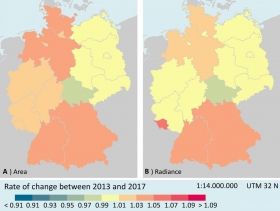The nights in the German federal states („Bundesländer“) has been getting brighter and brighter – but not everywhere at the same rate and with one peculiar exemption: light emissions from Thuringia decreased between 2012 and 2017. This is the result of a recent study by scientists Chris Kyba and Theres Küster from the GFZ German Research Centre for Geosciences together with Helga Kuechly from “Luftbild – Umwelt – Planung, Potsdam”. Kyba and colleagues published the study in the International Journal of Sustainable Lighting IJSL. This week, they updated the maps by including the 2017 data from a satellite-born instrument.
The team measured the change of light emissions for every German state, studying both the lit area and total radiance. The trends in the lit area show a clear distinction between East and West. The lit area of the states of the former GDR including Berlin stayed basically the same (growth less than 1 per cent), whereas the states in the western part of Germany increased in the area that is lit in the night. The lit area in Thuringia decreased by about 7 percent. With respect to the intensity of the lighting, the picture is more complex. Large areas in both East and West Germany show only marginal changes, while some states show growth rates of three to four per cent annually. Once again, Thuringia decreased in radiance.
Read more at GFZ Geoforschungszentrum Potsdam, Helmholtz Centre
Image: Map of German federal states ('Bundeslaender') and light pollution: Nearly all states got brighter with one peculiar exemption: Thuringia in the eastern part of Germany got darker over the last four years. (Credit: C. Kyba / T. Küster / H. Kuechly for the GFZ)


